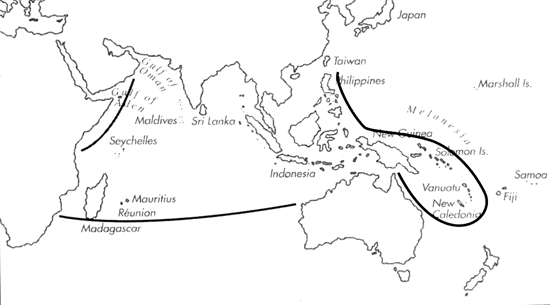Range: Indian Ocean: Mozambique and Tanzania to W. Australia (absent from the Red Sea); W. Pacific: Philippines to Melanesia and N. and N.E. Australia.
Description: Medium-sized to moderately large (usually larger in India than in the Pacific), moderately solid to solid (lightest specimens from N. Australia). Last whorl usually ventricosely conical; outline slightly to distinctly convex. Specimens from N. Australia with narrowest last whorls, specimens from Oman broadest. Aperture somewhat wider at base than near shoulder. Shoulder angulate to rounded. Spire of moderate height, outline slightly concave to slightly convex. Larval shell of about 2.5 whorls. About first 5-8 postnuclear whorls tuberculate. Teleoconch sutural ramps flat to slightly concave, with 2 increasing to 4-6 spiral grooves. Last whorl with variably spaced smooth to granulose spiral ribs at base, occasionally to shoulder.
| Shell Morphometry | ||
|---|---|---|
| L | 40-82 mm | |
| RW | 0.13-0.52 g/mm | |
| RD | 0.54-0.69 | |
| (N. Australia 0.54-0.59, Oman 0.62-0.69, other localities 0.56-0.65) | ||
| PMD | 0.73-0.86 | |
| RSH | 0.11-0.19 | |
Ground colour white. Last whorl with large axial clouds of olive or orangish tan to blackish brown. Surface pattern emphasized by bordering blue-grey background clouds. In some subadult specimens, ground orange to red; reddish colouration may persist to the adult stage. Spiral rows of alternating dark and light coloured dots and dashes extend from base to shoulder, on spiral ribs where these occur, producing a pronounced lineate pattern. Some specimens highly speckled by scattered white flecks. Larval shell white in E. Africa and Oman, grey to pale brown in India and W. Thailand, grey to red or orange in the Philippines, translucent grey in W. Australia, grey to orange in N. Australia and pale reddish brown in the Solomon Islands. Teleoconch spire with radial markings, matching surface and background clouds of last whorl in colour; on early postnuclear sutural ramps, maculation often reduced to regularly set dots at outer margin. Aperture white to bluish grey.
Periostracum yellowish or olive to reddish brown, varying in thickness, translucent to opaque, sometimes within the same specimen, with widely spaced tufted spiral ridges and fringed shoulders.
Dorsum of foot cream, mottled with orange or brown; a dotted black pre-marginal line merges into a large spotted black trilobate area at the centre of the anterior part. Sole of foot reddish brown or mottled brown, darker medially. Sides of foot white, mottled with brown. Rostrum buff, variously mottled with brown. Tentacles white, may be tipped with tan. Siphon white to buff, mottled with brown and red on dorsal half; tip of siphon white (Pl. 74, Fig. 28) (Kohn, 1978 & unpubl. observ.; Chaberman, pers. comm., 1981).
Radular teeth with a strong adapical barb opposite a large second barb; backward-pointing third barb with a recurved tip; neither a serration nor a basal spur present (Peile, 1939).
Habitat and Habits: Intertidal and uppermost subtidal; inhabiting sand under rocks, coral rubble and crevices beneath corals. Reported to occur in mixed colonies with C. monachus in E. New Britain (Richards, 1989). C. achatinus is known to prey on small fishes (Kohn & Nybakken, 1975). Egg capsules (N. Australia) within the same cluster vary from 10 x7 mm to 12-13x6-7 mm; capsules of larger females measure 17x13 mm or 19x10 mm. Capsules attached individually to hard substrate, e.g. bivalve shells.
Discussion: C. achatinus is similar to C. monachus, C. striolatus and C. catus in shell characters and feeding type; for comparisons, see the DISCUSSIONS of these species.

C. achatinus range map
This section contains verbatim reproductions of the accounts of 316 species of Conus from the Indo-Pacific region, from Manual of the Living Conidae, by Röckel, Korn and Kohn (1995). They are reproduced with the kind permission of the present publisher, Conchbooks.
All plates and figures referred to in the text are also in Röckel, Korn & Kohn, 1995. Manual of the Living Conidae Vol. 1: Indo-Pacific Region.
The range maps have been modified so that each species account has it own map, rather than one map that showed the ranges of several species in the original work. This was necessary because each species account is on a separate page on the website and not confined to the order of accounts in the book.